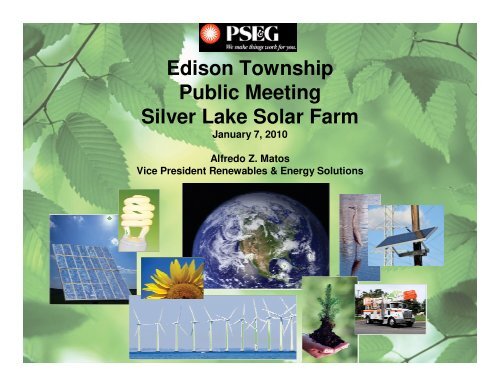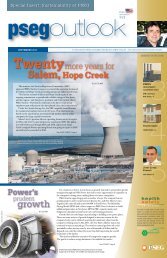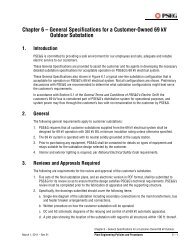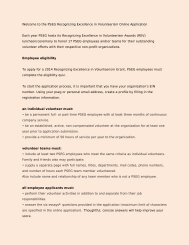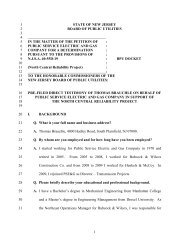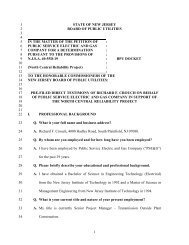Edison Township Public Meeting Silver Lake Solar Farm - PSEG
Edison Township Public Meeting Silver Lake Solar Farm - PSEG
Edison Township Public Meeting Silver Lake Solar Farm - PSEG
You also want an ePaper? Increase the reach of your titles
YUMPU automatically turns print PDFs into web optimized ePapers that Google loves.
<strong>Edison</strong> <strong>Township</strong><br />
<strong>Public</strong> <strong>Meeting</strong><br />
<strong>Silver</strong> <strong>Lake</strong> <strong>Solar</strong> <strong>Farm</strong><br />
January 7, 2010<br />
Alfredo Z. Matos<br />
Vice President Renewables & Energy Solutions
<strong>Public</strong> Service Electric & Gas<br />
New Jersey’s oldest & largest regulated electric and<br />
gas delivery utility<br />
150,000 miles of wire<br />
33,000 miles of pipe<br />
2.1M electric customers<br />
1.7M gas customers<br />
2,600 sq. mile territory<br />
$7.6B in revenues<br />
6,100 employees<br />
Four major unions<br />
24/7 operations
NJ’s Energy Master Plan….<br />
By 2020….<br />
• Reduce energy consumption by 20%<br />
• Reduce peak demand by 20%<br />
• 30% of energy supply will come from<br />
renewable sources
PSE&G’s Energy Efficiency Initiatives<br />
Energy Efficiency:<br />
Funding $236MM to implement energy<br />
efficiency programs using all-hands-ondeck<br />
strategies to create good paying<br />
jobs and help customers save<br />
energy/reduce energy bills<br />
Street Lighting:<br />
PSE&G to spend $50MM to replace<br />
mercury vapor municipal street lighting<br />
with more efficient induction fluorescent<br />
lighting.<br />
Vehicles:<br />
PSE&G investing in hybrid cars, light<br />
trucks, bucket truck prototypes
PSE&G’s<br />
Renewable Energy Initiatives<br />
<strong>Solar</strong> Loans. PSE&G is<br />
offering ~$250 million in<br />
loans to finance solar system<br />
installations (totaling 81MW) on homes,<br />
businesses, municipal buildings.<br />
<strong>Solar</strong> 4 All. PSE&G is investing $515MM to<br />
construct, own and operate 80MW in solar<br />
installations.
NJ has less PV solar radiation than certain other states…<br />
Yet NJ is #2 in the US for total solar capacity!
TM<br />
<strong>Solar</strong> 4 All - PSE&G owned solar<br />
• PSE&G will install, own and<br />
operate 80MW of solar systems<br />
throughout our electric service<br />
territory<br />
– 40MW of pole attached solar which is<br />
the largest pole mounted solar project<br />
in the world<br />
– 40MW will be installed on PSE&G<br />
properties as well as public and<br />
private third party sites
First 4 sites on PSE&G property:<br />
Name<br />
Size<br />
Installer<br />
<strong>Silver</strong> <strong>Lake</strong> <strong>Solar</strong> <strong>Farm</strong><br />
(<strong>Edison</strong>)<br />
Yardville <strong>Solar</strong> <strong>Farm</strong><br />
Linden <strong>Solar</strong> <strong>Farm</strong><br />
About 8,500 solar<br />
panels on 5.7 acres;<br />
2 MW<br />
About 19,000 solar<br />
panels on 16 acres;<br />
5.1 MW<br />
About 15,000 solar<br />
panels on 10 acres;<br />
3.6 MW<br />
J. Fletcher Creamer &<br />
Sons<br />
American Capital Energy<br />
Advanced <strong>Solar</strong><br />
Products<br />
Trenton <strong>Solar</strong> <strong>Farm</strong><br />
About 5,500 solar<br />
panels on 3.8 acres*;<br />
1.3 MW<br />
Sun <strong>Edison</strong><br />
In addition to creating jobs, these 4 projects will produce enough annual energy<br />
to power about 1,300 homes and eliminate about 6,700 tons of CO2 emissions, the<br />
equivalent of removing nearly 1,200 cars from the road for one year!<br />
*Note: reflects updated value for space requirement as of 1/20/2010
Benefits:<br />
• Create green jobs<br />
• Attract & retain businesses in NJ<br />
• Provide all customers access to <strong>Solar</strong> Energy<br />
• Support the development of clean renewable<br />
energy technology<br />
• Reduce pollution / carbon footprint<br />
• Support NJ Energy Master Plan targets<br />
Serve as a role model for sustainable communities!
How <strong>Solar</strong> Works<br />
January 7, 2009<br />
Lyle Rawlings, P.E.<br />
CEO Advanced <strong>Solar</strong> Products
A BRIEF HISTORY OF SOLAR ENERGY<br />
60,000 B.C. the first known passive solar house is built of interlocking<br />
mammoth tusks<br />
100 A.D. Greeks and Romans used “burning mirrors” to focus sunlight as<br />
weapons of war to ignite fires and burn sails of enemy war ships<br />
1839 Edmund Becquerel, the French experimental physicist, discovered the<br />
photovoltaic effect while experimenting with an electrolytic cell<br />
1904 Albert Einstein, in his first published scientific paper, explains the<br />
photovoltaic effect by describing light in terms of “Quanta” he called “photons”.<br />
This laid part of the foundation for Quantum Theory.<br />
1921 Albert Einstein wins the Nobel Prize for his theory explaining photovoltaics<br />
1958 Vanguard I, the first PV-powered satellite, is launched<br />
1973 The Terrestrial solar industry is born at a conference in<br />
Cherry Hill, New Jersey<br />
2003 Worldwide production capacity for Photovoltaics surpasses 500<br />
Megawatts per year, growing at a 35% per year pace. Grid connected<br />
PV grows at a rate of 100% per year.
The Photovoltaic Effect<br />
Phosphorous has<br />
one more electron<br />
than Silicon, and<br />
Boron has one less.<br />
When these<br />
materials are<br />
substituted into a<br />
Silicon crystal, it<br />
creates an electric<br />
field that sweeps<br />
electrons freed by<br />
light energy out of<br />
the cell and to a<br />
load. No material is<br />
consumed and the<br />
process could<br />
continue<br />
indefinitely..<br />
P<br />
Si<br />
B<br />
The Photovoltaic Effect
from<br />
“Mid-Atlantic States Supply Curve Analysis” - JBS Energy, Inc.<br />
How Power Prices Are Set After Deregulation<br />
and How Demand Reduction Benefits ALL Ratepayers<br />
Highest-priced unit of power bid in to PJM for a<br />
particular hour sets price paid to ALL Generators<br />
Price<br />
Demand Reduction:<br />
Reduced Price is Value to All Ratepayers<br />
Demand Reduction:<br />
Reduced Usage is Value to Participants<br />
Demand
Environmental Benefits<br />
30-year Lifetime Emission Savings<br />
2,000 kW System<br />
Air Quality<br />
Resource Conservation<br />
SMOG 500 tons NOx<br />
Oil 220,000 barrels, or<br />
Acid Rain 800 tons SOx<br />
Global 40,000 tons CO2<br />
Warming<br />
Coal 64,000 tons, or<br />
Natural 14000 million<br />
Gas<br />
cubic feet
<strong>Solar</strong> is desired for Jobs and Economic Growth…<br />
1.4<br />
Among today’s<br />
energy resources,<br />
PV is the most<br />
intensive job<br />
creator per MWH<br />
generated.<br />
1.2<br />
1<br />
0.8<br />
0.6<br />
0.4<br />
0.2<br />
JOBS<br />
CREATED:<br />
PERSON-YEARS<br />
PER 1000 MWH<br />
0<br />
PV<br />
COAL<br />
Sources: Renewable Energy Policy Project, “The Work That Goes Into Renewable<br />
Energy”, and Mid-Atlantic <strong>Solar</strong> Energy Industries Association
<strong>Solar</strong> energy helps to grow the economy:<br />
In a study by the Center for Business and Economic<br />
Research at Univ. of Nevada, Las Vegas, it was found<br />
that the growth in renewables due to Nevada’s<br />
Renewable Portfolio Standard would add $665<br />
million per year to the GSP (as well as 5,000 jobs).<br />
<strong>Solar</strong> energy can create export revenue (most U.S.<br />
made PV modules are exported) while reducing fuel<br />
imports, thus improving the trade balance from both<br />
ends.
Residential PV Systems
Flat-mount Rooftop Arrays
Fixed-Tilt Rooftop Arrays
PV Power for Emergency Facilities:<br />
Bayonne Midtown School
A<br />
D<br />
V<br />
A<br />
N<br />
C<br />
E<br />
D<br />
S<br />
O<br />
L<br />
A<br />
R<br />
P<br />
R<br />
O<br />
D<br />
U<br />
C<br />
T<br />
S<br />
PV<br />
Inverter<br />
3<br />
Meter<br />
Main<br />
Distribution<br />
Panel<br />
Emergency<br />
Power<br />
Panel<br />
T<br />
R S<br />
A W<br />
N I<br />
S T<br />
F C<br />
E H<br />
R<br />
Generator<br />
1 In a power outage, the existing emergency power system<br />
automatically disconnects from the outside electric grid<br />
2 The Generator starts<br />
The Inverter re-starts in a special “Generator Support Mode” and<br />
3<br />
automatically shares the building’s s emergency power load with the<br />
Generator, keeping fuel use to a minimum<br />
• When power is restored, the Inverter goes back to normal mode,<br />
supplying solar power to the building<br />
• The entire process is fully automated<br />
1<br />
2
Details of Proposed Site Improvements<br />
January 7, 2009<br />
Daniel R. Urban<br />
Business Manager<br />
J. Fletcher Creamer & Son Inc.
Current Site Conditions
Current Site Conditions
Current Site Conditions
Proposed Development
Site Specific Details<br />
• 8500 +/- 235w Panels<br />
• 2.1 MW/DC of Generation<br />
• 2,500,000 kwh per year<br />
• Life Expectancy Exceeds 35 Years<br />
• Will Improve Site Aesthetics
Fixed-Tilt Ground Array – Aerial View
Power conversion: Inverters convert DC power to AC
Fixed-Tilt Ground Array – View from South
Fixed-Tilt Ground Array – View from North
Thank you for Attending<br />
Questions <br />
January 7, 2009


